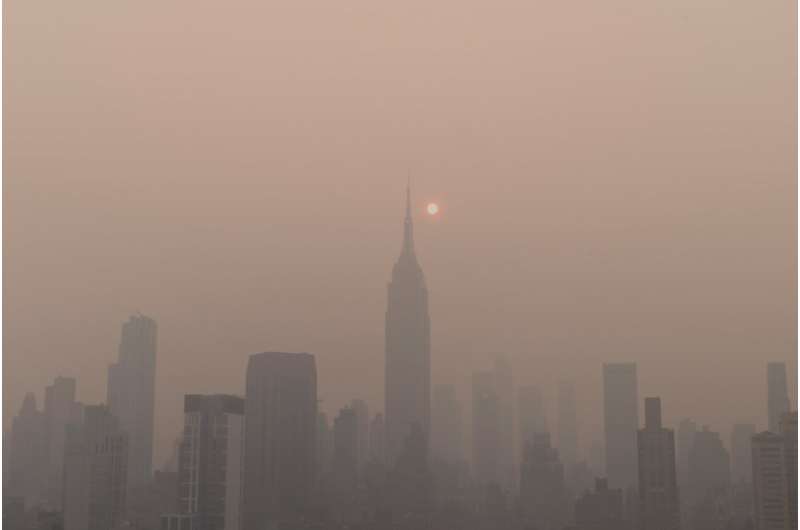This article has been reviewed according to Science X's editorial process and policies. Editors have highlighted the following attributes while ensuring the content's credibility:
fact-checked
peer-reviewed publication
trusted source
proofread
Study examines impact of exposure to ultrafine particles on mortality in New York

Outdoor air pollution was estimated to cause 4.2 million premature deaths worldwide per year as of 2019. This is largely due to exposure to particulate matter (PM), a combination of tiny solid particles and liquid droplets in the air that can travel deep into the respiratory system and cause serious health problems.
PM2.5—PM less than 2.5 microns in diameter—is what is usually considered when assessing health risks. However, the health impacts of ultrafine particles (UFPs), which are far smaller than the PM2.5 particles, are less understood.
A new study, led by a team of interdisciplinary researchers at the University at Albany, has found a link between long-term UFP exposure and increases in mortality in New York, especially among underserved populations.
Findings were recently published in the Journal of Hazardous Materials.
"Ultrafine particles are airborne particles that are less than 0.1 micrometers or 100 nanometers in diameter (PM0.1). That is about the size of 1/1,000 human hair. Since they are so tiny, they are easily inhaled into the distal branches of lungs, quickly absorbed into the bloodstream, and can pass through organ barriers," said senior co-author Shao Lin, a professor of environmental health sciences at UAlbany's School of Public Health.
"UFPs are currently not a criteria pollutant and therefore there are no regular monitoring stations to measure its concentration. Since UFPs are very small, they are difficult to measure and require specialized instruments that are not as widely available as for larger particles. With a lack of data, it is difficult to study their impacts."
Tracking UFPs in New York
To quantify multiple-year UFPs in New York, the researchers used GEOS-Chem-APM, a 3D global model of atmospheric chemistry with size-resolved advanced particle microphysics developed by researchers at UAlbany's Atmospheric Science Research Center (ASRC) that can capture accurate particle numbers across space and time.
The quantified UFP concentrations were then compared to New York State vital records. For the deceased, these records provide cause of death, demographic information and residential address. Using a statistical analysis, the researchers connected the association between long-term UFP exposure and various mortality outcomes, including disparities by sex, age, race-ethnicity, urbanicity (New York City vs. non-New York City) and seasonality.
"Borrowing an idea from economics, which allows for comparing outcomes in different groups at different times, we were able to make an association between long-term UFP exposure and various mortality outcomes," said lead author Quan Qi, a Ph.D. student in UAlbany's Department of Economics at the College of Arts and Sciences, who has been who has been working with Lin for more than two years.
Long-term UFP exposure was found to be significantly associated with increases in total non-accidental mortality, particularly for cardiovascular (stroke and pulmonary heart diseases) and respiratory diseases. Disparities existed within Black and Hispanic populations, young children, older adults and non-NYC residents being more vulnerable to the effects of UFPs. These risks were also observed to be higher during winter months.
"Our findings are consistent with the adverse health impacts seen previously for other air pollutants like PM2.5 and PM10. Similar to these aerosol pollutants and other gaseous pollutants, UFPs disproportionately affect certain sociodemographic groups, including minorities and low-income populations," said co-author Arshad Nair, a post-doc fellow at ASRC.
Reducing air pollution impacts
While there is a declining trend in PM2.5 concentrations in New York, recent research has suggested that UFPs do not follow such a trend and can actually increase during some periods. The compositions of ultrafine particles are expected to change in the future due to more wildfires and non-tailpipe emissions associated with electric vehicles.
UAlbany researchers plan to conduct more detailed studies to improve exposure assessment of UFPs, understand the biological mechanisms of UFP pollution health impacts, and to identify the most effective mitigation strategies.
They will share findings with the New York State Department of Health and Department of Environmental Conservation.
"Interdisciplinary research teams are important to addressing societal problems," said co-author Fangqun Yu, senior research faculty at ASRC. "Our study brought together diverse expertise, techniques and perspectives, helping us better understand the complex interactions between air pollution, health outcomes and sociodemographic factors. This type of collaboration is essential to build our community's climate and health resilience."
Other collaborators include researchers at the University of Arizona, the University of California, Berkeley and Hong Kong Baptist University and Sun Yat-sen University in China.
More information: Quan Qi et al, Hidden danger: The long-term effect of ultrafine particles on mortality and its sociodemographic disparities in New York State, Journal of Hazardous Materials (2024). DOI: 10.1016/j.jhazmat.2024.134317




















